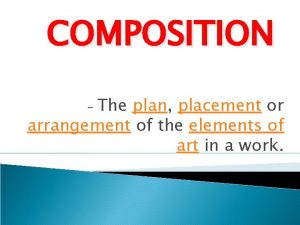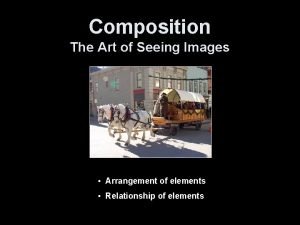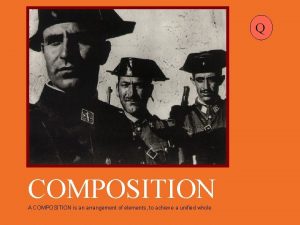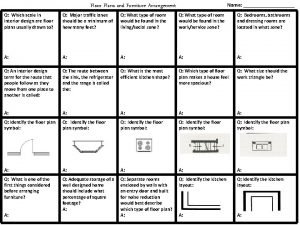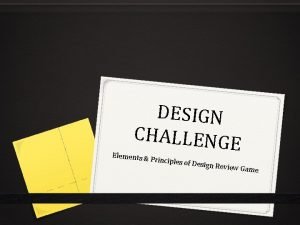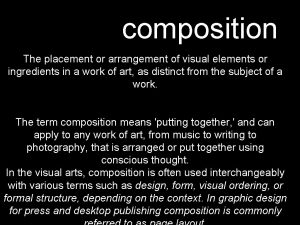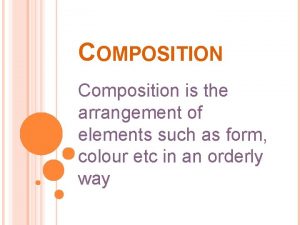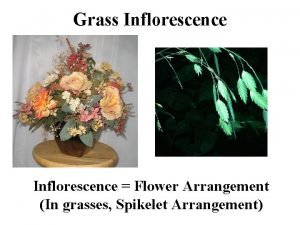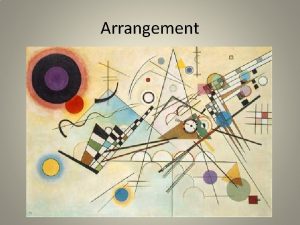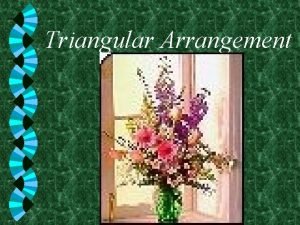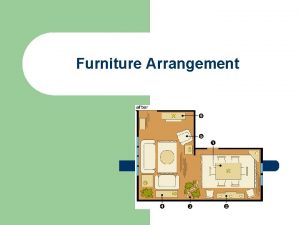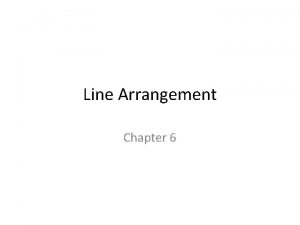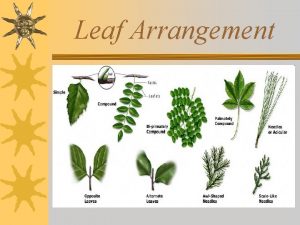COMPOSITION The plan placement or arrangement of the








































- Slides: 40

COMPOSITION The plan, placement or arrangement of the elements of art in a work. -

ELEMENTS OF ART � LINE- 1 DEMINTIONAL (1 -D) � SHAPE� FORM- 2 DEMINTIONAL (2 -D) 3 DEMINTIONAL (3 -D)

Shape VS Form What is the difference? � Shape � Form is two-dimensional height and width is three-dimensional height and width and depth

The path of a moving point at the edge of a flat shape, or outline of a solid object. It is longer than it is wider. Lines do have some width as well as length, this is called measure. Types of line refers to straight, curvy, horizontal, vertical, diagonal, zigzag, implied, and angular. Direction pertains to the movement that a line may have or seem to indicate. Location refers to the placement of a line.

Shape is a two-dimensional area made by connecting lines that establish the contour of an object. Shapes may be positive or negative, biomorphic or geometric. Shapes may stand out also by a difference of value, color, or texture.

The three dimensional projection of a shape, it has volume, dimension, appears to have mass. This element is frequently used in sculpture. It may also refer to the overall organization of the work of art,

The appearance of lights and darks found in a work of art. These range from black to white with numerous shades of gray in between.

The character of a surface created by the response of vision to the wavelength of light reflections. It identifies objects, creates moods, and affects emotions. (warm, cool, primary, secondary, intermediate, analogous, and complementary).

The roughness or smoothness of a surface. Texture can be real, tactile(sandpaper), or illusion (looks soft, but not).

Interval of measurable distance between pre-established points. Space can be limited or shallow, or extended or deep in design. Two-dimensional space has height and width. Three-dimensional space has height, width, volume, and time. Deep--foreground, middle ground, background. Shallow--foreground and background.


Haymaking by Pieter Brueghel The Elder

Farm Yard by Mabel Dwight


A Helping Hand by Tim Cox

Fall Plowing by Grant Wood


Farm Courtyard in Normandy by Claude Monet

Still Life with Apples and Pears by Paul Cezanne

Phases of Drawing a Still Life 2) Develop the Proportion of the objects (Cited: Starting to Draw, by Wendon Blake, Drawings by Ferdinand Petrie, Watson-Guptill Publications/New York, 1981. ) ØDraw the basic forms for each object – spheres, cylinders, boxes, cones… ØVases would be drawn first as a cylinder, planters would be drawn a initially as a box in 2 -pt perspective….

Phases of Drawing a Still Life 3) Fill in the Detail of the objects’ form (Cited: Starting to Draw, by Wendon Blake, Drawings by Ferdinand Petrie, Watson-Guptill Publications/New York, 1981. ) ØOnce you have the basic form of each object developed, then… Øbegin work on the details to complete the object. ØFor example, develop the handles, spouts on teapot, leaves, flower petals…

BEGIN WITH THE END IN MIND!!! � PENCIL PRESSURE- Give your own definition

TEXTURE � How something feels to the touch or looks to feel


PAINTING �Overlay- The process of layering wet media in order to create depth �Media- Anything used to create art �Ferrell- Metal ring that hold bristles to wood of brush �Contamination- Mixing of pure colored paints

Art Advertisement �TITLE �DATES �TIMES �LOCATIONS �CONNECT TO AUDIENCE

Still Life or Observational Drawing


WHY DRAW STILL LIFES? A still life is a drawing or painting of inanimate objects - such as fruit, pottery and flowers. The artist has a chance to arrange these objects (unlike a landscape) in order to work out the composition of their artwork. In addition, they are a great way to practice and develop observational drawing techniques.


TIPS FOR SETTING UP YOUR OWN STILL LIFE: 1. Choose your location: light source is the key to a strong painting or drawing. The creation of a strong range of values will give life and impact to your work. 2. Architectural features such as a window frame or door can add direction to a composition. Think about the overall arrangement and composition of your page. 3. Choose your objects with thought! Beginners should avoid oddly shaped objects that might look 'wrong' even when you've got it 'right'. Choose objects that will make an interesting drawing and demonstrate use of value and composition. 4. Arrange the group. When arranging, consider compositional elements, avoiding bland central postitioning and symmetry. Once you get the hang of it, be a little daring! Try something with a unique perspective or challenge your skills. 5. Avoid piling fruit in a bowl - let it spill from a bag, or be half-eaten on a plate… and you don’t have to use fruit! 6. View your arrangement through an empty slide frame (make one out of card) to assess the composition and consider its placement on the paper.

Starting your STILL LIFE: 1 - Create a VALUE SCALE 10 Steps - start with white and end with black… - should see an even “jump” in value from one step to the next. - you will use this to create a Full-range of value in your still life

Ways to Create Value (SHADING)

Adding Value:

TIPS FOR WORKING ON YOUR STILL LIFE: 1. Drawing Position - sit with a board in your lap, held at an angle (45 degree) so you can see your subject AND your drawing at the same time. 2. PLAN before you draw! You can use a viewfinder if you want… Think about the composition and how you will arrange elements on the page. 3. Sketch out your composition lightly! Work out proportions and perspective BEFORE you get detailed and add value. You can use a light pencil (2 h) or vine charcoal. 4. After working out your contours, planes and shapes, begin adding VALUE. Add value slowly - layering to build up deep tones. DO NOT define edges with lines, define them with shifts in value. This will take some planning. 5. Make sure you achieve a full range of value. Beginners tend to draw too lightly and end up with a washed-out looking drawing. See a value scale if you need reference.


�BASES �FACES �VERTICES �EDGES �PRISMS �PYRAMIDS �CONGRUENT �PARALLEL http: //schools. houstonisd. org/lovett

RODEO ART �BEGIN WITH THE END IN MIND �ALL ENTRIES DUE NEXT WEEK �COMPOSITION �VALUE �SPACE �MULTI –MEDIA

RODEO ART FIND SUBJECTS IN BOOKS OR MAGAZINES DISCUSS WITH TEACHER DECIDE ON MEDIUM BEGAN ART WORK DUE NEXT WEEK

RODEO ART Ranch life (past or present), cowboy or rodeo scenes. 2. Any imaginative country and Western scene, animals or plant life symbolic of the West. 3. A scene depicting cowboy and/or American Indian paraphernalia. 4. Wildlife native to Texas or symbolic of the Old West and its natural inhabitants
 L arrangement composition
L arrangement composition What are the four parts of the art of seeing?
What are the four parts of the art of seeing? Composition arrangement art
Composition arrangement art Intended message
Intended message Tank arrangement plan
Tank arrangement plan Floor plan arrange furniture
Floor plan arrange furniture The circular chart used to remember color relationships is?
The circular chart used to remember color relationships is? Hình ảnh bộ gõ cơ thể búng tay
Hình ảnh bộ gõ cơ thể búng tay Lp html
Lp html Bổ thể
Bổ thể Tỉ lệ cơ thể trẻ em
Tỉ lệ cơ thể trẻ em Gấu đi như thế nào
Gấu đi như thế nào Chụp tư thế worms-breton
Chụp tư thế worms-breton Bài hát chúa yêu trần thế alleluia
Bài hát chúa yêu trần thế alleluia Các môn thể thao bắt đầu bằng tiếng đua
Các môn thể thao bắt đầu bằng tiếng đua Thế nào là hệ số cao nhất
Thế nào là hệ số cao nhất Các châu lục và đại dương trên thế giới
Các châu lục và đại dương trên thế giới Công thức tính thế năng
Công thức tính thế năng Trời xanh đây là của chúng ta thể thơ
Trời xanh đây là của chúng ta thể thơ Mật thư tọa độ 5x5
Mật thư tọa độ 5x5 101012 bằng
101012 bằng độ dài liên kết
độ dài liên kết Các châu lục và đại dương trên thế giới
Các châu lục và đại dương trên thế giới Thơ thất ngôn tứ tuyệt đường luật
Thơ thất ngôn tứ tuyệt đường luật Quá trình desamine hóa có thể tạo ra
Quá trình desamine hóa có thể tạo ra Một số thể thơ truyền thống
Một số thể thơ truyền thống Cái miệng nó xinh thế chỉ nói điều hay thôi
Cái miệng nó xinh thế chỉ nói điều hay thôi Vẽ hình chiếu vuông góc của vật thể sau
Vẽ hình chiếu vuông góc của vật thể sau Nguyên nhân của sự mỏi cơ sinh 8
Nguyên nhân của sự mỏi cơ sinh 8 đặc điểm cơ thể của người tối cổ
đặc điểm cơ thể của người tối cổ Thế nào là giọng cùng tên?
Thế nào là giọng cùng tên? Vẽ hình chiếu đứng bằng cạnh của vật thể
Vẽ hình chiếu đứng bằng cạnh của vật thể Phối cảnh
Phối cảnh Thẻ vin
Thẻ vin đại từ thay thế
đại từ thay thế điện thế nghỉ
điện thế nghỉ Tư thế ngồi viết
Tư thế ngồi viết Diễn thế sinh thái là
Diễn thế sinh thái là Dạng đột biến một nhiễm là
Dạng đột biến một nhiễm là Số nguyên tố là số gì
Số nguyên tố là số gì Tư thế ngồi viết
Tư thế ngồi viết
